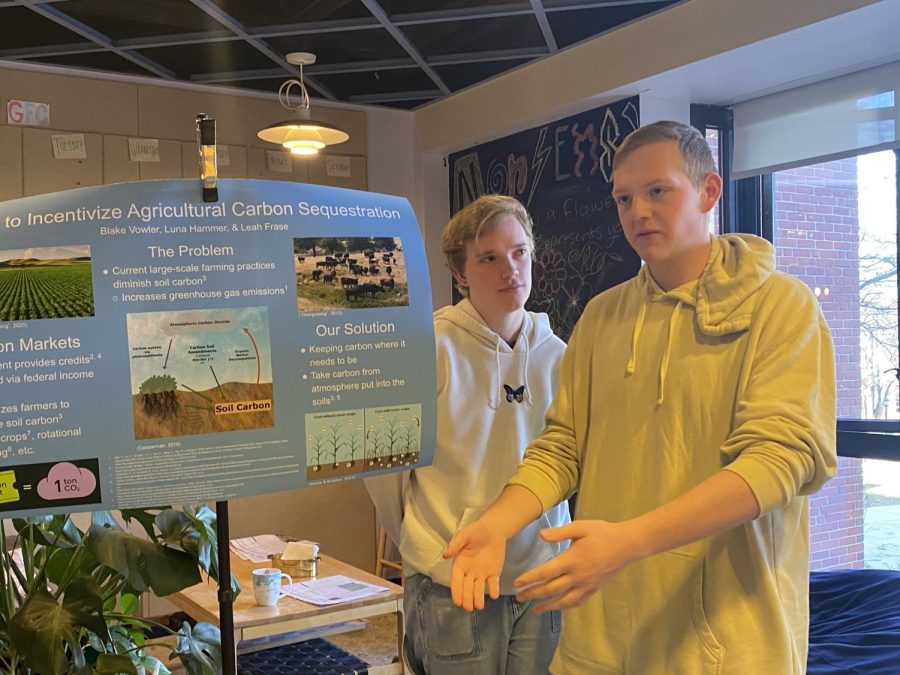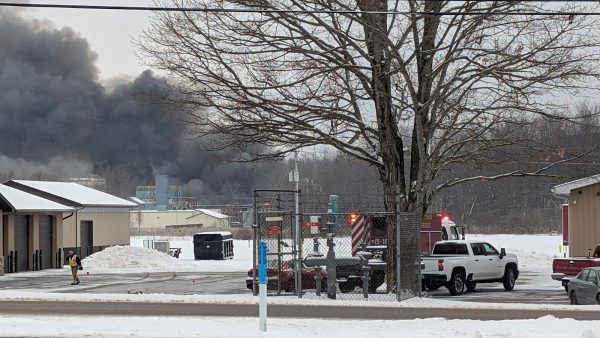GFC hosts climate teach-in on sustainable agriculture
Luna Hammer, ’25, and Blake Vowler, ’25, present their work at a climate teach-in in Grounds for Change on Tuesday, April 4. Their project focused on different ways to incentivize agricultural carbon sequetration.
There are very few things that could motivate college students to roll out of bed for an optional 8 a.m. event. Free coffee is one of those things. Packed with animated students, Grounds for Change buzzed with the sound of chatter and the hiss of milk steamers on the early morning of Tuesday, April 4. The reason? A climate teach-in focusing on sustainable agriculture. And the free coffee.
The event was hosted as part of the Graduate Programs in Sustainability at Bard College’s WORLDWIDE Teach-In, a “bottom-up education event, focused on just solutions to the climate crisis in local communities and globally.” Taking place on and around March 29, the global program aimed to spark “real dialogue” in a variety of educational settings that do not typically discuss climate change.
“The climate crisis is here and students and young people around the world are rising up to demand just solutions to this urgent and existential crisis,” the website stated. “But if you were to go into classrooms around the world, you would never know that we are facing this generation-defining inflection point. Where is the climate crisis in the classroom? What are our educators doing to prepare us for the world we’re inheriting?”
The program aimed to empower students and educators alike to take the time to inform their peers about the wide-reaching effects of climate change.
As part of the WORLDWIDE Teach-In, students in Professor of Environmental Science and Sustainability Eric Pallant’s ENVSC 210 “Soil to Plate” class researched topics related to sustainable agriculture in teams of two before designing posters and synthesizing what they learned into short two- or three-minute oral presentations. Topics ranged from reducing meat consumption to agricultural additives to methods of food labeling that incentivize sustainable consumer choices.
For their project, Renee LaGrosse, ’26, and Ethan Scott, ’25, focused on how to mitigate the adverse environmental effects of manure lagoons — man-made pits of animal waste that usually exist on farms. The two students stood in front of their poster titled, “Don’t let that s— go to waste.”
“You want to learn about s—?” LaGrosse called out to her friend walking by.
“I’d love to. It’s my favorite thing ever!” Katelyn Bombalski, ’26, replied, coming closer.
“Okay, so welcome to the s— show. This is s— talk 101,” Lagrosse laughed before launching into a brief explanation of her topic. “As you know, animals produce manure. And this manure is being spread on farms like fertilizers and nutrients for their crops. And basically it’s not being implemented in a way that’s sustainable for the environment because they’re just sitting in manure lagoons or manure pits.”
The primary gas manure lagoons release is methane, which is produced when organic matter undergoes anaerobic decomposition — decomposition without oxygen. Methane is an extremely potent greenhouse gas,
meaning it has a more significant impact on the acceleration of climate change than other greenhouse gases, like carbon dioxide. The solution?
“To cover this (manure lagoons) up and collect the gases,” Scott said. “Actually, 79 million metric tons (of) greenhouse gases are released from manure every year — just from the manure lagoons, not from the fertilizer being spread on the field. So that’s a lot of gas that’s going to waste.”
In his research, Scott found that estimates said collecting methane from manure lagoons could offset approximately 79 million metric tons of the 80 billion tons of natural gas used in the United States every year. This offset means less fracking and less of the other harmful side effects of natural gas.
Once the manure has undergone decomposition and is no longer releasing methane, it can then be used as fertilizer on agricultural fields. The use of a farm’s animal manure as nutrients for the farm’s crops is an example of a closed-loop system, which is the pinnacle of sustainability.
While covering up manure lagoons is one way to create a more sustainable agricultural system, Sam Dzierba, ’25, and Kylee Hollerich, ’25, focused on an entirely different topic: Marketing in grocery stores. Specifically, they taught about carbon labeling, a system that ranks the sustainability of products based on the quantity of greenhouse gases used to produce them. The carbon labeling system would feature prominently on products’ packages and hopefully incentivize customers to make climate-conscious choices.
The three most greenhouse gas-intensive foods are lamb, cheese and beef, Dzierba said. Because Americans eat so many of these products, they have one of the most greenhouse gas-intensive diets in the world. Hollerich argues this means Americans could benefit significantly from the carbon labeling system.
“What is America known for? We’re known for a hamburger, right?” Hollerish said. “A lot of other countries are — their natural food is rice with some sort of bean added to it. That’s what their main food is and they eat it for, like, three meals a day. If you’re eating that three meals a day, your carbon footprint is definitely going to be lower than if you’re eating a hamburger every meal. We’re known for eating meat here and other countries are known for eating vegetables and rice and grains and that way their main meals are getting protein through plants.”
Carbon labeling is not a new idea. Although not mandated or regulated in a standardized manner, voluntary carbon labeling already exists in parts of Europe.
Dzierba believes carbon labeling would have a positive effect on consumer habits and that consumers would be willing to adopt the system. She cited a study from the Journal of Cleaner Production which found that some Europeans are willing to pay up to 20% more for a product they know is more environmentally friendly.
Additionally, she said she could foresee carbon labeling as an initiative that the college may be willing to adopt in some form in the future.
“My research methods class actually last year examined the carbon footprint of Allegheny dining, so I kind of was able to see — I saw every single thing that they ordered all year, and it was thousands upon thousands of rows in a spreadsheet,” Dzierba said. “We were kind of able to see the average carbon emissions that were created from the food at the school. So I think, since we have that data from the class, we could at least use that as an example because we did submit that to the college and created some sort of recommendation, like, ‘Hey, let’s cut down on this,’ or, ‘Let’s cut down on this.’ And they were actually really willing and accepting to look at our recommendation and kind of look at our food plan again.”
Until some sort of carbon labeling system is implemented on a large scale, though, Hollerich and Dzierba recommend eating more environmentally friendly foods, like vegetables and grains in order to cut down on your carbon footprint.
By the time the WORLDWIDE Teach-in is done, Bard College estimates that more than 250 colleges, universities and high schools in more than 40 countries will engage an estimated 30,000 students, according to their website.
Young people around the globe were the driving force behind the teach-in. They were the ones using their time and energy to serve their communities and educate their peers about climate change, which organizers of the event said was the goal.
“The biggest threat to our future,” reads the WORLDWIDE Teach-in website, is “thinking that someone else will lead, that someone else will solve the climate crisis. Now, not next month, not next year, we all need to step up.”

Anna Westbrook is a junior from the Washington, D.C. area. They are majoring in Environmental Science and Sustainability with a concentration in law &...








